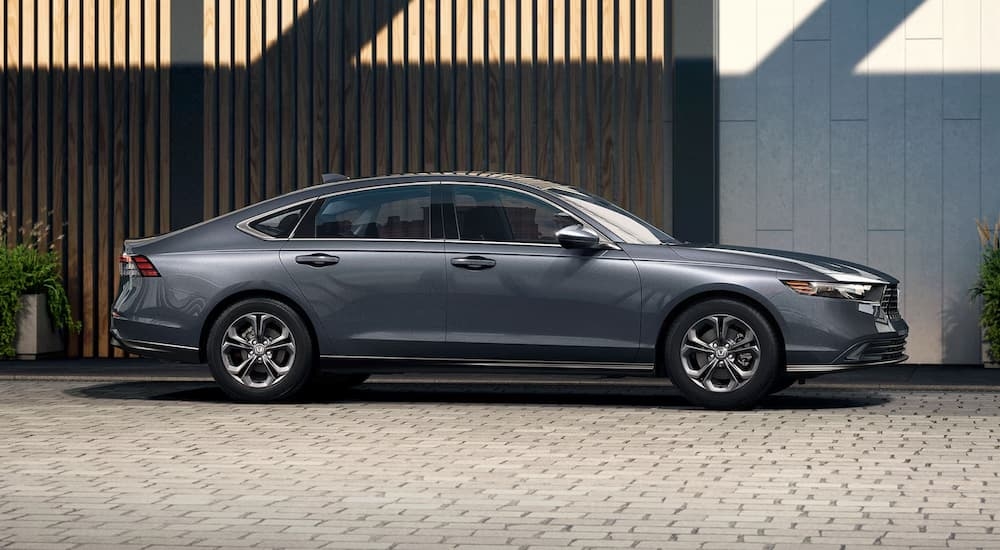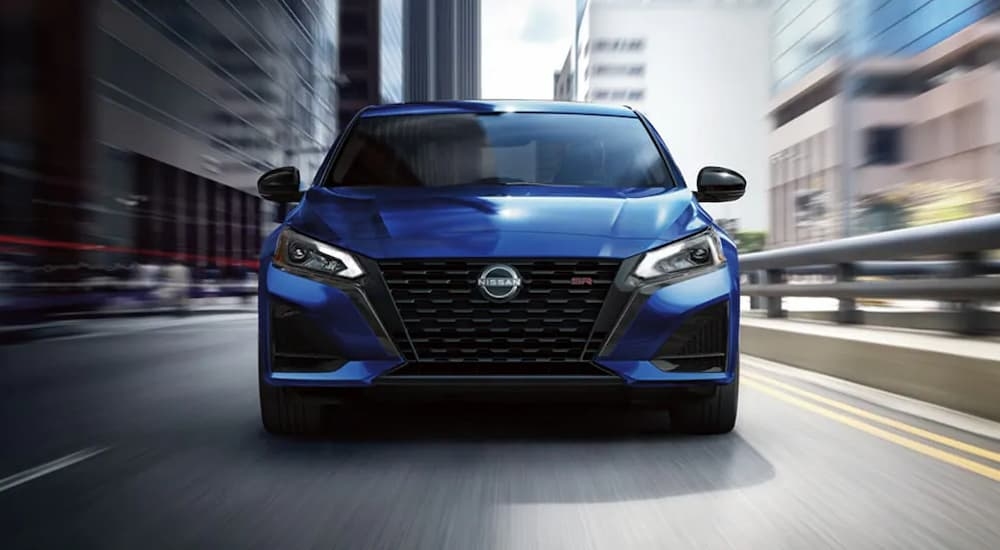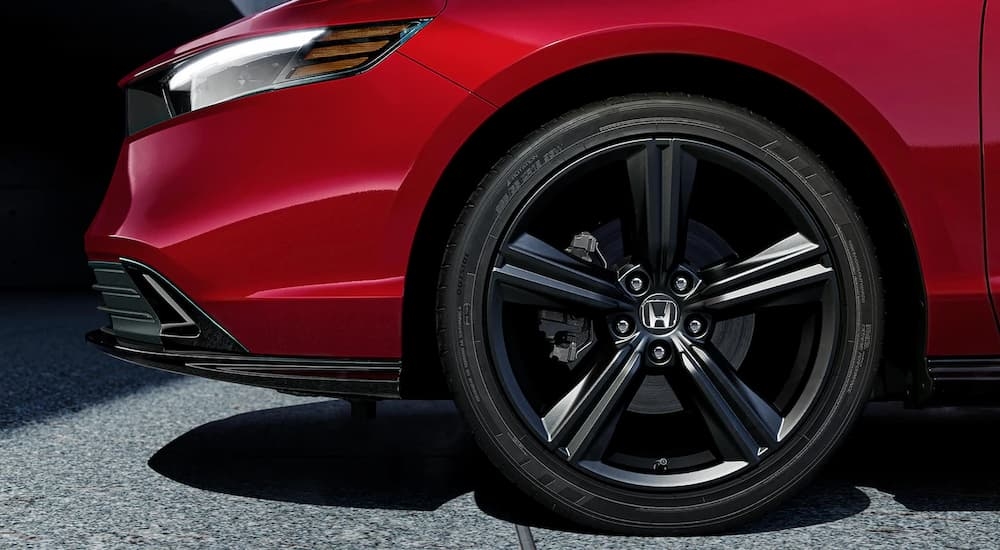
The Nissan Altima could learn a lot from the Honda Accord. Honda’s midsize sedan has been on the market for almost 50 years, seamlessly integrating new and emerging tech to maintain its edge throughout the decades. From its full suite of advanced comfort, convenience, and safety tech to its sporty styling, spacious interior, and rock-solid warranty coverage, it’s little surprise that the Accord is one of Honda's longest-running models. With such a track record of success, can any other midsize models hope to compete?
The Nissan Altima has long played second fiddle to the Honda in the hotly contested category, but it’s certainly worth comparing the two models if you’re considering a Honda Accord for sale. The current-generation Altima hit the market in 2019, but Nissan did treat it to a 2023 refresh that made some important upgrades in the styling and tech departments. Let’s take a closer look at both models and see which sedan comes out on top in the matchup between the 2024 Accord and the 2024 Altima.
Technology Features
While solid performance, reliability, and fuel economy were once enough to attract and retain drivers, in-vehicle tech has become an increasingly important consideration. While some brands have put safety, comfort, and infotainment tech at the forefront, others are still relying on an aging formula that sees many of the more advanced features limited to pricier trims or the options list. This is certainly the case with the 2024 Nissan Altima. The sedan might be a relative bargain, but when you step into the cabin, it soon becomes clear how Nissan managed to keep the price so low.
Take automatic climate control, for instance. While this important comfort-enhancing feature is included standard on every 2024 Accord trim, Nissan doesn’t even offer it as an available option on the S, SV, and SR trims. If you’re looking to enjoy a comfortable cruise without having to fiddle with the AC controls, you’ll have to spring for the Altima’s SL trim. It’s the same case for those advanced driver-assistance systems (ADAS) that play such a vital role in ensuring safety. Every Accord comes standard with a Traffic Sign Recognition System, a clever feature that uses the sedan’s camera to detect traffic signs and display the relevant data on the standard 10.2-inch driver information interface located just behind the steering wheel. Nissan also offers a version of this cutting-edge tech but limits it to the upper trims, with the base model missing out yet again. It also might be a little tough to pick out on the Altima’s own digital gauge cluster, which, at seven inches, trails the Accord by a noticeable margin.

The most glaring omission would probably have to be adaptive cruise control. There are few features that enhance the driving experience quite as much as cruise control, especially the new adaptive systems that can respond to surrounding traffic to pump the brakes or hit the accelerator as needed. Adaptive Cruise Control comes standard on every 2024 Accord but isn’t even an available option on the Altima S. Most surprisingly, the Accord’s own base trim isn't that much more expensive. That small increase in price makes all the difference in interior tech, with the Accord standing out for its well-appointed cabin.
Cargo and Passenger Space
As the go-to choice for so many families, the midsize segment has always made cargo and passenger space a priority. Whether you’re on carpool duty, packing for a long weekend trip, or just trying to work through your list of errands, a roomy ride can have a big impact on the overall driving experience. Measuring in higher, longer, and wider than the Altima, it’s little surprise to learn that Honda’s sedan has a definitive edge when comparing interior volume. Both the Accord and Altima provide seating for up to five passengers, but that doesn’t mean they’re evenly matched in terms of comfort.
The Accord offers better front and rear headroom than the Altima, and while the gap isn’t all that large, a little extra room can have a big impact when trying to ensure comfort on longer rides. This is particularly relevant when it comes to the backseat, which is a good litmus test for any vehicle. Some brands design their vehicles with backseats that struggle to accommodate all but the most diminutive adults, but Honda is a refreshing exception. The Accord’s rear legroom measures 40.8 inches, which is a noticeable improvement over the 35.2 inches found in the back of the 2024 Altima. Again, this might not be something many drivers weigh at the time of purchase, but just wait until you find yourself asking your brother-in-law to ride with his knees up around his ears.
The Altima also trails the Accord in total passenger volume, offering 100.6 cu.ft. to the Honda’s 105.7 cu.ft., and the same is true when it comes to cargo volume. The Accord’s trunk is another area of note, with 16.7 cu.ft. compared to the Altima at 15.4 cu.ft. The Accord doesn’t just beat out the Altima when it comes to cargo volume; it also beats most of the midsize segment, including other perennial midsize contenders like the Toyota Camry, Hyundai Sonata, and Subaru Legacy in this all-important metric, making the Honda an exceedingly practical choice for those who never want to feel short on space.
Warranty Coverage
When choosing between models, picking out colors, and adding available features and equipment packages, it’s easy to get caught up in the excitement during the car-buying process. Factors like fuel economy, horsepower, seating, and cargo room usually come under close scrutiny when weighing a new vehicle purchase, but the same isn’t necessarily true when it comes to warranty coverage. No driver wants to imagine a day when that shiny new car, truck, or SUV is going to limp its way into the mechanic’s shop, but savvy buyers know just how important reading the fine print can be.

How do the 2024 Accord and Altima compare as far as warranty coverage is concerned? By some measures, the two midsize models are pretty competitive. Both the Honda and Nissan sedans come standard with a limited powertrain warranty that covers the first three years or 36,000 miles of driving, as well as a generous powertrain warranty for the first five years or 60,000 miles, but these policies do differ in one important way. While the Accord comes with free scheduled maintenance for the first two years or 24,000 miles of ownership, the Altima lacks complimentary scheduled maintenance altogether. This means Altima drivers will be left to fend for themselves when tackling maintenance tasks that play an important role in keeping a car on the road, such as oil changes, air filter replacements, tire rotations, and vehicle inspections.
See for Yourself How the Accord Stands Out
The Accord is a standout when it comes to reliability, providing drivers with the sort of peace of mind that few other brands can match. The Accord’s suite of advanced safety, convenience, and comfort tech is also hard to beat, especially when you consider that so many of these features are standards across the entire 2024 lineup. From Adaptive Cruise Control and a Traffic Sign Recognition System to an expansive 12.3-inch touchscreen infotainment display and wireless charging pad, the Accord is proof that even a model with an almost 50-year history can still learn a few new tricks. The Accord’s interior speaks for itself, offering a spacious ride that puts an emphasis on cargo space and passenger comfort. Honda’s midsize sedan even manages to best the Altima in some key categories we haven’t had time to touch on, including fuel economy. If you want to learn more about what makes the 2024 Accord such a gem in the midsize segment and take a test drive, stop by and visit the team here at Klein Honda today.
